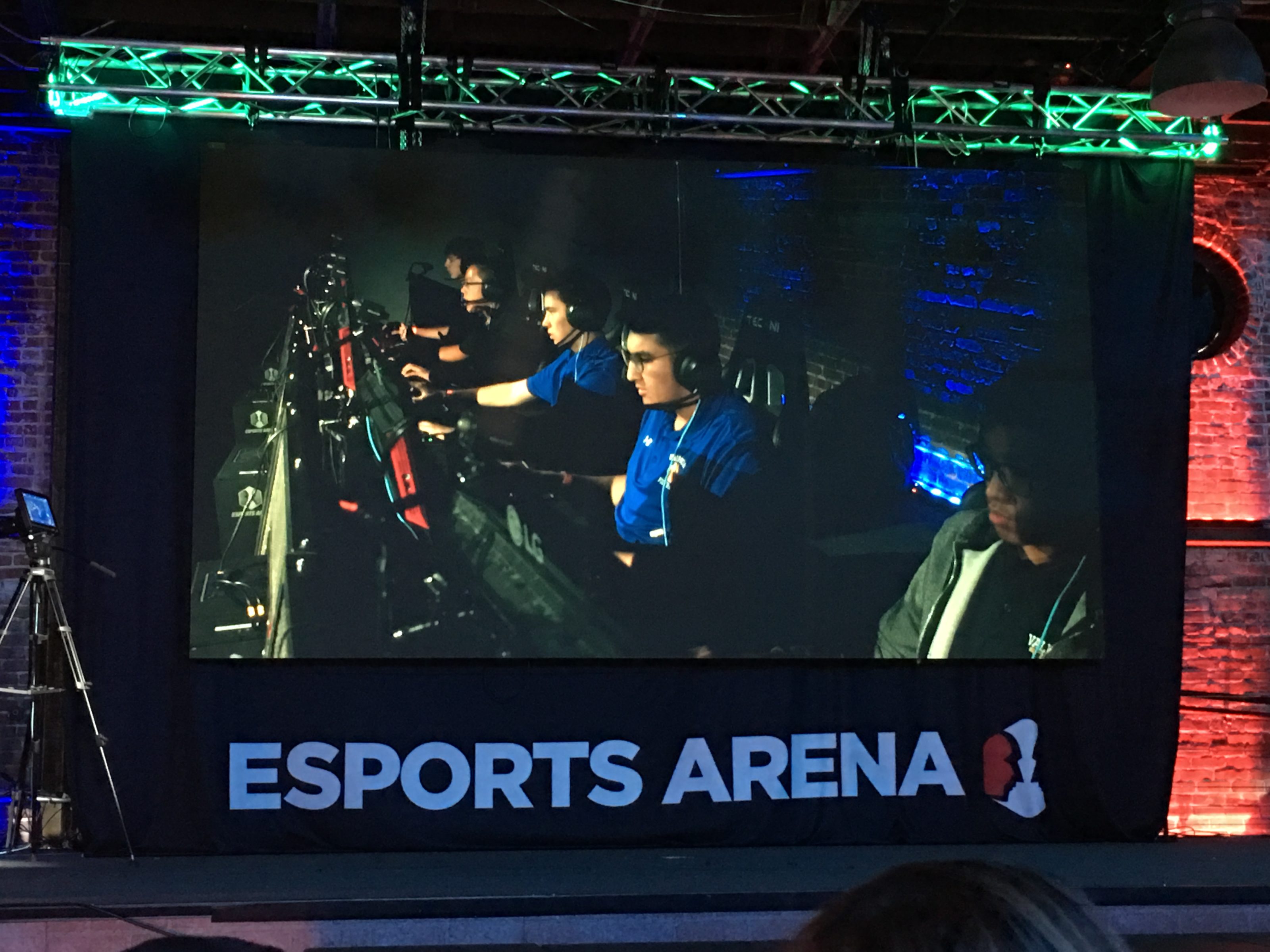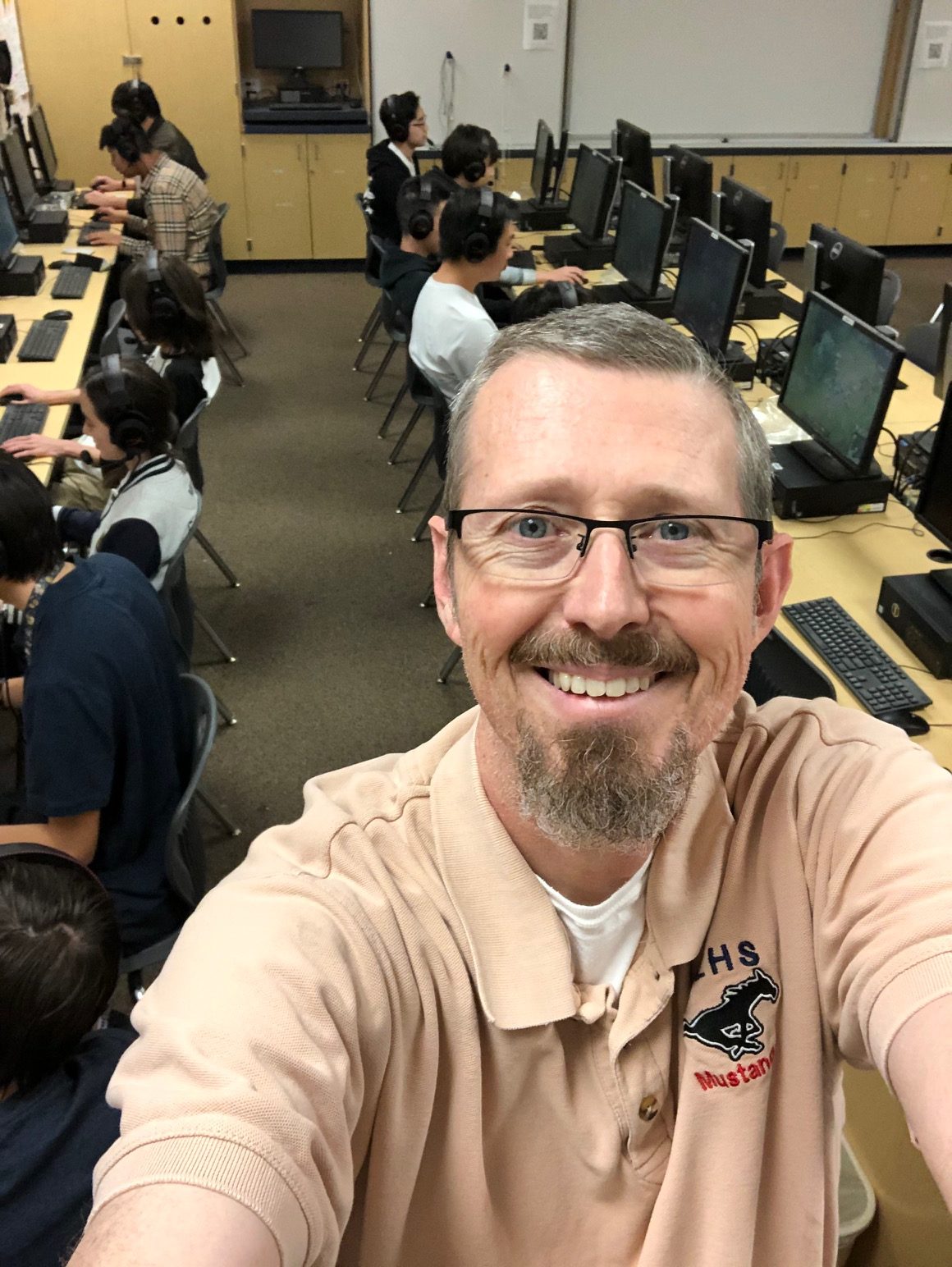“Gaming teaches really important skills, such as being part of a team, being able to communicate effectively and decisively, knowing your role in a group, and being able to perform your role well.”
—Dan Eliot, Association of Placentia-Linda Educators
The team trained for this moment all year. They developed strategy with their coach, reviewed video of their opponents to determine strengths and weaknesses, and scrimmaged against other teams. As the Yorba Linda High School team prepares for a match with a squad from Vancouver, British Columbia, the players put on headsets, settle into chairs and focus their eyes on computer screens for the impending arena battle — in this week’s esports league match.

Teams from the four Placentia-Yorba Linda high schools compete for the championship at UC Irvine’s Esports Arena.
Esports, short for electronic sports (and with a variety of spellings), is a form of sport competition using video games. Long organized by gamers and enthusiasts, esports became an international phenomenon in the late 2000s, growing and evolving into a billion-dollar industry with an estimated audience of nearly 500 million worldwide. The popularity spurred the creation of esports clubs in colleges and high schools as early as 2008, with more than 130 colleges and more than 300 high schools now in on the competitive gaming action.
With 100 million people watching last year’s League of Legends World Championship, the visibility of competitive gaming is at an all-time high. Couple that with recent studies that show educational benefits of playing video games and the increased job opportunities in the booming industry, and esports is likely coming to a high school near you. And it’s not just a boys’ club, with estimates that 35 to 45 percent of gamers are girls.
Placentia-Yorba Linda Unified School District (PYLUSD) is what you could call an early adopter, with vibrant esports clubs at all four of its high schools. Yorba Linda High School computer science teacher Dan Eliot got involved in 2017 when he was approached by two of his female students who wanted to start an esports club on campus and convinced him to serve as adviser. During the club’s second year, Orange County Department of Education started the Orange County High School E-Sports League to provide students with an opportunity for fun competition and learning about science, technology, engineering, art and math (STEAM).

Dan Eliot
“It started unofficially with assorted on-campus clubs across the district,” says Eliot, general manager of the esports team and member of Association of Placentia-Linda Educators (APLE). “It became more official when our district administrators took notice and realized that esports are a very nice tie-in with career technical education, STEAM and computer science.”
Brent Willis, a 17-year AP economics and U.S. history teacher at Esperanza High School, got involved in 2017 when student Ben Tecker asked for his help in creating an esports club and a competitive team on campus. Tecker was already an accomplished gamer and wanted to connect with fellow students to compete in the Orange County E-Sports League he helped to create, now called the North American Scholastic Esports Federation (NASEF).
Willis became the club’s adviser and the team’s general manager (kind of like the equipment manager for an athletic team) — with responsibilities including holding regular team and club meetings, forming active rosters, handling all administrative items needed for students to be eligible for competition, holding practices outside of school hours, recruiting new members, promoting the club on campus and in the community, and providing a safe and inclusive environment where students can share experiences and enjoy competing with each other online.
“Students who normally wouldn’t fit in or who didn’t feel like they had a place to go on campus to share their interests now have a group and an environment to call their own.”
—Brent Willis, Association of Placentia-Linda Educators
“Esports have opened many doors on our campus and in our district. Students who normally wouldn’t fit in or who didn’t feel like they had a place to go on campus to share their interests now have a group and an environment to call their own,” says Willis, also an APLE member. “It’s instilled pride and confidence in a segment of the student population that was shy and introverted. Districtwide, it’s connected students from all of our high schools and allowed us to communicate and develop new avenues for future collaboration.”
With its popularity, competitive gaming has become a lucrative endeavor, with top players earning six figures a year and sponsorships from video game giants like Blizzard Entertainment and Riot Games. And for Tecker, working to create a home for gamers in PYLUSD earned him more than an extra life: The Esperanza graduate won a $15,000 Dreamers & Doers Luminary Scholarship from Disneyland in recognition of his work to create the esports league, which now includes more than 280 schools worldwide.
“Ben decided to donate $4,000 of his scholarship money to the Esperanza esports program so we could buy new computers, monitors, gaming chairs, mice and keyboards, and other equipment for our esports lab,” Willis says. “Because of Ben’s generosity, our esports team has doubled in size in one year, and we now play in perhaps the most advanced esports labs in NASEF.”
More than trophies and high scores
The esports teams from the four PYLUSD high schools compete every year in a massive NASEF-sponsored tournament held at UC Irvine’s Esports Arena — the first facility of its kind on a college campus. NASEF partners with UC Irvine, which is conducting gaming research, including on the students and coaches involved in NASEF. Over the past two years, the young gamers have competed in the mega-popular multiplayer battle arena game League of Legends for an etched crystal trophy, but they gain so much more.

Economics and AP History teacher Brent Willis says the games may be on computers, but the competition and community are definitely real.
“Last year, our team was crowned co-champions in the tournament,” says Willis. “It’s an exciting trip because we receive a campus tour provided by UC Irvine esports players, and our students are exposed to college life and how big collegiate esports has become. It really opened our students’ eyes to the possibilities after high school in the world of gaming, entertainment and video game design.”
Jason Parker’s Valencia High School esports team has hoisted the trophy two years running. Parker, a 21-year math and computer science teacher, is the general manager of the team, which boasts a club of 130 members who compete in several different games, even holding a Super Smash Bros. tournament on campus to raise funds for the team. Parker says it’s an amazing experience to see his students in a different light and watch them communicate and collaborate to achieve goals.
“Esports programs bring together kids from all walks of life,” says Parker, a member of APLE. “They promote learning communication skills, team play and game theory.”
The positive talk about video games and benefits of gaming might come as a shock to those who grew up in an era where video games were considered a waste of time by many. But not only is it a common and popular pastime for people all over the world, research now shows that moderate gaming is good for young people — with studies showing cognitive, creative, social, emotional and motivational benefits associated with video games.
“Many studies have examined psychological correlates of and consequences of video gaming, and the results overwhelmingly support the idea that video gaming produces many of the same kinds of benefits as other forms of play,” wrote psychology professor Peter Gray in Psychology Today. “Play has always provided the major context through which children make and interact with friends, and there is reason to think that video gaming serves that function for many children today.”
Eliot can see the benefits in his students.
“It excites them about competition and learning in ways that perhaps other areas of school life do not,” Eliot says. “It also legitimizes for the students (and their families!) that gaming is not all just fluff and wasting time. Gaming teaches really important skills, such as being part of a team, being able to communicate effectively and decisively, knowing your role in a group, and being able to perform your role well.”
And these young gamers aren’t just plopping on the couch and vegging out every afternoon. They practice several times a week, plan multiple strategies, watch video of opponents, communicate and work together to solve problems, and prepare for the rigors of organized competition. When they enter the arena and collaborate to defeat the opposing team, they’re competing just the same as any basketball or soccer team in the country.
Maintaining a special space for students
Growing up in the “Atari Generation,” Parker has been playing video games since he was a child. Being able to create a special place for students to learn and grow through gaming has been especially rewarding.
“I enjoy seeing my students in a different light, watching them communicate and work together for a common goal,” he says.
For Willis, the thrill of competition isn’t limited to his students. Part of helping provide this space means getting a front-row seat to the energy, emotion and exciting competition of the game.
“Being there with my players during matches and experiencing the palpable excitement of competing with and beating other teams is the best part of the job,” he says. “Our esports program is one of the best in the area, so on match days the environment is thrilling. Our players cheer each other on during matches and boost each other up after defeats. Seeing how much they appreciate each other is the best part of it all.”
Eliot agrees, saying that in his classroom he only gets to see his students through an academic lens, while his work with them through esports allows him a glimpse of them experiencing the joys and sorrows of competition. He says there’s so much more going on than some video games.
“I hope that in their lives, esports encourages them to stay connected with school and education. I hope that it makes the kids feel validated for their love of gaming. I take pride in these students when I see them improving socially and academically, communicating well, happy and engaged. It’s great to see kids come out of their shells and shine due to esports!”
Want to Bring Esports to Your School?
Advice for educators interested in learning more about esports:
“Don’t reinvent the wheel. There are great support systems available in CIF (California Interscholastic Federation), NASEF (North American Scholastic Esports Federation), and other leagues. NASEF even provides remote coaching (currently free) for many of their teams! Ready or not, esports is coming to every public school over the next few years. Embrace it, since it’s good overall for kids!”
—Dan Eliot, Yorba Linda High School esports general manager
“It’s a great opportunity for our kids. You don’t even have to know how to play the games — I wish I did, so that I could help them improve faster. But they usually figure that out on their own with experience, friends, and online. It takes time and decent computers, so if you have those, you’ll have plenty of student interest.”
—Jason Parker, Valencia High School esports general manager
“Your students know what they’re doing and are your greatest assets. Their excitement at forming a club will take control of the situation, and you’ll see them flourish in the roles you give them. Ask [your administration] for what you need, and generally you can receive help. School districts want to provide more spaces like esports to their students.”
—Brent Willis, Esperanza High School esports general manager